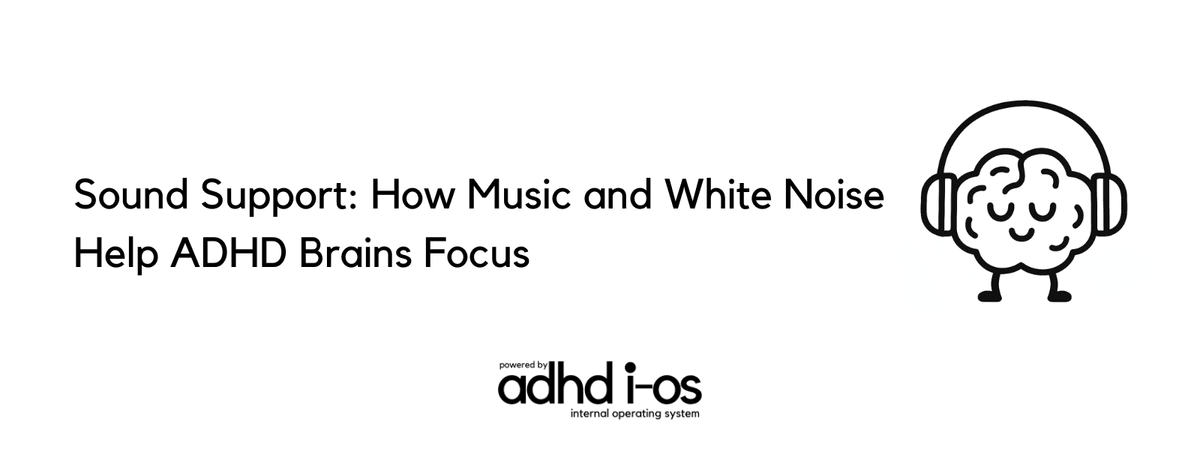Sound Support: How Music and White Noise Help ADHD Brains Focus
Sound Support: How Music and White Noise Help ADHD Brains Focus
Sound Support: How Music and White Noise Help ADHD Brains Focus
You sit down to work. The room is quiet. Too quiet.
Instead of helping you focus, the silence turns into a void. Your brain drifts. You open tabs. Wander to the kitchen. Feel overwhelmed before you’ve even begun.
Then… you put on music.
Click. Your fingers start typing. Ideas come into focus. Time passes.
For people with ADHD, sound isn’t a distraction. It’s a focus tool. Music and white noise help regulate stimulation, activate attention, and support executive function. Let’s dive into the why, and how to make it work for you.

Why ADHD Brains Need Sound
ADHD brains often operate in a state of under-stimulation, struggling to maintain alertness when the environment feels flat.
Music and sound create structure. They give the brain something consistent to tune into, a sensory “anchor” that keeps us grounded and present. Instead of fighting silence, we fill it with something that helps us stay on track.
How Music Helps ADHD Brains Focus
Research shows that the right kind of music, especially rhythm-based or instrumental, can improve attention, motivation, and task initiation for ADHD brains.
A few fascinating findings:
- A study in Communications Biology found that music with rhythmic amplitude modulation (AM) significantly improved attention in adults with ADHD symptoms.
- Researchers working with Brain.fm found that neural phase-locking (basically music designed to match brainwave rhythms) boosted focus, especially for people with ADHD.
- Many ADHDers report that listening to lo-fi beats or instrumental music helps them start tasks faster, stay in the zone longer, and feel less overwhelmed.
Bottom line? Music can act like dopamine scaffolding, especially when it’s upbeat, predictable, and free of distracting lyrics.
Why White Noise (and Color Noise) Works Too
Sometimes, music is too emotional or too busy. That’s where color noise come in.
White noise is steady and unchanging, like static, a fan, or soft rainfall. Pink and brown noise are lower and softer, with more of a natural feel. For ADHD brains, these sounds can help:
- Mask distractions: Drown out the creaky door, loud AC, or neighbor’s lawn mower.
- Reduce sensory overwhelm: Create an even, calming sensory baseline.
- Increase focus: Studies show consistent improvements in cognitive performance.
In fact:
- A study from Oregon Health & Science University showed that white and pink noise improved task performance in children and young adults with ADHD but didn’t help neurotypical peers the same way.
- A meta-analysis published on ScienceDirect found small but meaningful benefits in using color noise to improve learning and attention in ADHD populations.
- And a growing number of apps now offer ADHD-friendly sound environments designed to reduce distraction and support flow (we love Brain.fm and Noisli).
How to Build Your “Sound Toolbox”
There’s no one-size-fits-all sound for ADHDers. What works for one brain might overwhelm another. So, experiment. Try different sounds with different tasks, and see what feels right.
Here are a few starter tips:
- Lo-fi beats or classical music is good for writing, admin work, or solo projects
- Color noise or rain sounds are great for repetitive tasks, reading, or staying grounded
- Binaural beats or AM-modulated music are nice for deep work or meditation
- Playlists, timers, or Pomodoro methods help prevent over-focusing or burnout
- Create “sound rituals”: A specific playlist or soundscape can become a focus cue for your brain over time
When Sound Doesn’t Help
Not every task benefits from background noise. And not every ADHD brain responds positively to sound all the time. A few moments to skip the soundtrack:
- You're doing deep creative or emotional work that needs internal silence
- The music has lyrics that draw your attention away
- You’re already feeling overstimulated or anxious
- The volume is too high or the tempo too intense
The key is tuning into what your brain needs in the moment. Sound should feel supportive, not like pressure.
Sound is a Strategy, Not a Shortcut
ADHD brains aren’t “bad at focus.” They just focus differently.
When we give our brains the input they actually need, things start clicking into place. Sound can be one of the most powerful (and easiest to access) supports for attention, motivation, and task completion.
Try this: choose one new sound strategy, like lo-fi beats or pink noise, and pair it with a task you usually avoid. See what changes. Sometimes the smallest shift in input leads to the biggest change in output.
Want more science-backed tools that actually make sense for your brain?
Join the adhd i-os community where we turn brain research into real-world strategies.

